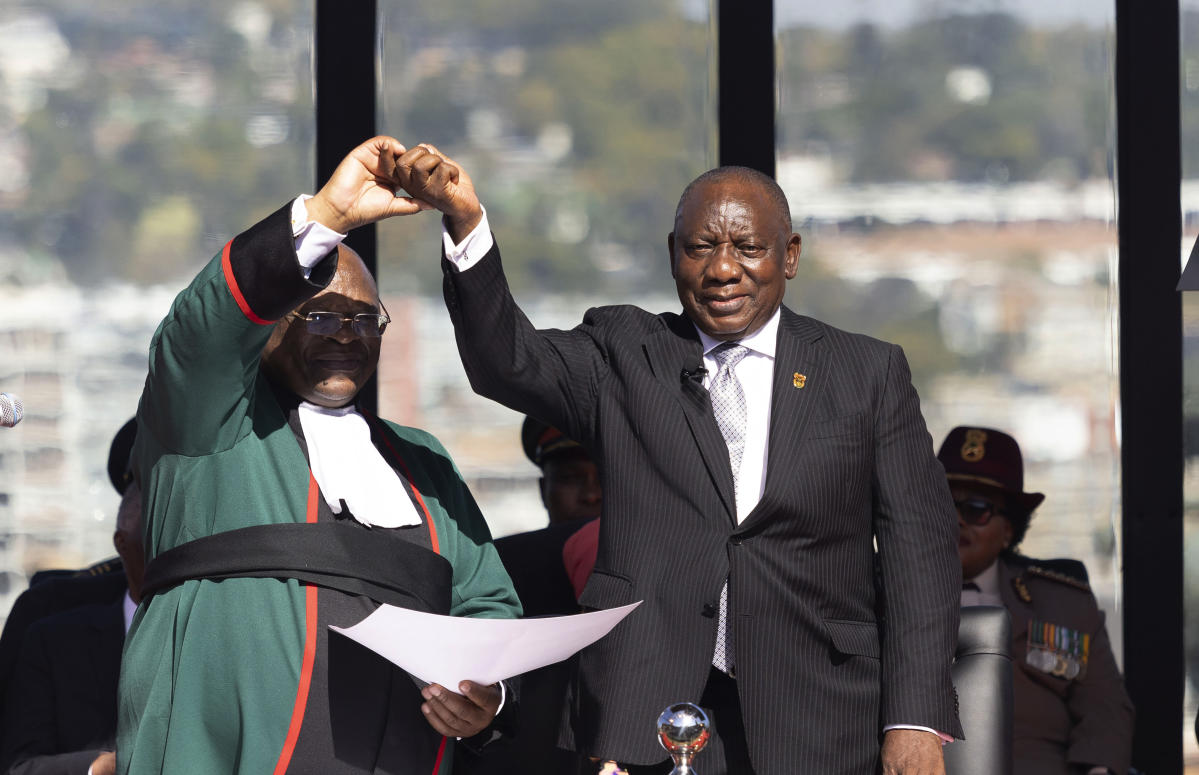CAPE TOWN, South Africa (AP) — South African president Cyril Ramaphosa has included seven different parties in his cabinet in an unprecedented power-sharing deal in the continent’s most industrialized country, after the African National Congress lost its majority in parliament in a key election outcome in late May.
Ramaphosa’s announcement of the new cabinet on Sunday evening puts South Africa in uncharted political territory after three decades of dominance by the ANC, which liberated the country from apartheid’s white minority government in 1994 and has ruled ever since.
The new multi-party cabinet was the culmination of a month of tense and sometimes bitter negotiations between Ramaphosa’s ANC and the Democratic Alliance, the white-led former main opposition party that has now agreed to share power with the ANC.
Although the coalition consists of eleven parties, including seven with cabinet positions, the agreement largely rests on the ANC and the DA – the two largest parties – putting aside their ideological differences and their two decades of political enemies to work together.
Below is an overview of the new coalition, which faces the challenge of solving South Africa’s deep socio-economic problems.
ANC retains most cabinet positions
Ramaphosa reappointed the ANC’s Paul Mashatile as his deputy president and also kept ANC officials in charge of the key ministries of finance, trade and industry, foreign affairs, defence and justice. The ANC, which won the largest share of the vote in the election with 40%, holds 20 of the 32 ministerial posts in the cabinet.
Keeping the Foreign Ministry under ANC leadership is also likely to mean a continuation of South Africa’s openly pro-Palestinian, anti-Israel stance. The ANC is the driving force behind South Africa’s highly sensitive case at the United Nations High Court accusing Israel of genocide in Gaza. South Africa will also play a major role in foreign affairs when it takes over the chairmanship of the Group of 20 developed and developing countries next year.
Concessions to the DA
Ramaphosa gave the DA six ministerial posts, including appointing DA leader John Steenhuisen as agriculture minister. While the DA had pushed for the trade and industry portfolio as the second largest party, it was given deputy ministerial posts in trade, industry and finance, and those areas could be the toughest test of whether the ANC and the DA can work together.
The left-wing ANC and the centrist DA disagree on many economic policies, including the ANC’s flagship Black Economic Empowerment affirmative action program, which aims to increase opportunities for black people in business. The ANC continues to insist it is necessary to right the wrongs of apartheid, but the DA has said it wants to scrap the policy and replace it with one in which race is not a determining factor.
Racial connotations
The coalition faces greater challenges on the issue of race, particularly the ANC, the party that liberated South Africa from white minority rule, and the DA, which is seen by some as a party that focuses on white interests minority of the country, making up 7% of the population of 62 million people.
The prosecutor has strenuously denied this characterization and has support among many black South Africans, but race remains a burning issue given South Africa’s history of brutal racial segregation under a white minority government.
Ramaphosa also made the leader of the Freedom Front Plus party part of his new cabinet. It has its roots in former right-wing parties representing white interests, and while it has softened its stance considerably, that will be a new test of whether South Africa can put race aside in the most politically diverse government it has ever had .
South Africa’s third and fourth largest parties have refused to join the coalition, simply because of the participation of the white DA and Freedom Front Plus.
Steep challenges
Both Ramaphosa and Steenhuisen have committed to working together, and the DA backed Ramaphosa for a second term in a parliamentary vote last month, a significant first step in their new partnership. But the coalition government faces major challenges. While South Africa is positioning itself as a leading voice for its continent and the wider developing world, its problems are undermining that.
South Africa has one of the highest inequality and unemployment rates in the world, officially standing at 32% across the board and a staggering 45% for young people aged 15 to 34. public services, epitomised by rolling nationwide power cuts that reached record levels in 2023.
These were all reasons why South African voters turned away from the ANC in the May 29 elections.
___
AP Africa News: https://apnews.com/hub/africa







